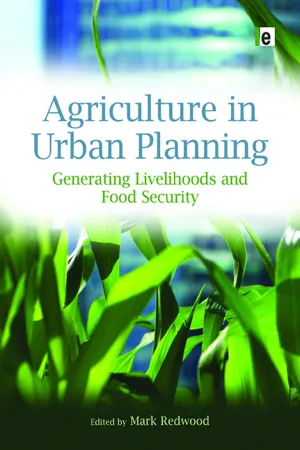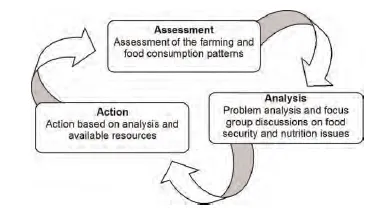![]()
1
Household Food Security Among
Urban Farmers in Nairobi, Kenya
Eunice Wambui Njogu1
INTRODUCTION
Since the 1960s, residents of Kamae had lived in slum conditions, but in the year 2001 they were allocated small landholdings by the local administration of the Government of Kenya. Prior to the start of this research project, observation indicated that these landholdings could potentially increase the diversification and intensification of food-production systems. A baseline survey conducted between June and July 2005 revealed none of the 300 respondents surveyed had received any form of organized agricultural training. Therefore, no organized farming was observed. Because the extension service of the Ministry of Agriculture and Livestock and Fisheries Development was farmer-driven, only more prosperous farmers sought crop and livestock extension services. As a result, the majority of poor farmers in Nairobi manage on their own, getting no assistance or advice, which is necessary for the enhancement of their food production skills particularly in the diversification of agricultural systems (Foeken and Mwangi, 2000).
The government has been restructuring and partially privatizing the public extension system to improve extension-service delivery to all farmers regardless of their socio-economic class (Government of Kenya, 2004). However, according to Ishani and Lamba (unpublished work, 2007), urban and peri-urban agriculture and livestock (UPAL) is not recognized in this policy. Fortunately, the National Livestock Extension Programme (NALEP) has been introduced in Nairobi province to support farmers (Z. Ishani and D. Lamba, unpublished work, 2007).
Without the inclusion of UPAL as a policy issue in agriculture and livestock policies, the social and economic benefits UPAL has on vulnerable groups cannot be fully realized (Z. Ishani and D. Lamba, unpublished work, 2007). When well developed, UPAL plays an important role in cities because it improves the nutrition status of household members, generates income, provides employment and conserves the environment.
‘Stunted’, ‘underweight’ and ‘wasted’ are indices used by the World Health Organization (WHO) based on the measurement of height, skin thickness (fat) and age to determine the nutritional status of the subject (WHO, 1995). In most cases, children are used as they represent an indicator of the general well-being of a community based on their intake of food. Children who are wasted are considered chronically malnourished. The results of the baseline survey showed that 62 per cent of children below five years old were stunted, 53.7 per cent were underweight and 31 per cent were wasted, whether mildly, moderately or severely. Their caloric, vitamin A and iron intakes were below recommended dietary allowances (RDA) established by the WHO. The assessment of people's nutrition knowledge on such important macronutrients (carbohydrates and proteins) and micronutrients (vitamin A and iron) showed that 49.7 per cent had no idea about them. Research in Korogocho, Nairobi showed higher energy intake among urban farmers than non-farmers (Foeken and Mwangi, 2000). The exposure of this lack of agricultural and nutritional knowledge combined with the observed poor nutritional status necessitated the design and implementation of an intervention. The intervention was to introduce the concept of growing a diversity of crops and rearing small livestock to enhance households’ food security.
As a result of this diversification of crops and livestock-rearing, household income increased in several ways. First, if they were marketed, the surplus food crops and livestock as well as their products fetched extra income. Second, the increased availability of food crops relieved the households’ income from food purchases. Then, due to this increased income, households’ food purchases became more diverse so people could incorporate higher quality foods in their diet (Bonnard, 2001). Therefore, households’ food security was enhanced by increased availability and access to diversified diets.
Selected respondents were trained on how to utilize their small land-holdings to produce a diversity of crops, rear small livestock and also to teach nutrition. This was done in collaboration with the Ministry of Agriculture and Ministry of Livestock and Fisheries Development. The households were provided with the fencing material, seeds, seedlings and small livestock of their choice. All this was expected to lead to enhancement of household food security as the initial step towards poverty eradication. This paper covers the objectives, methodology and findings of the research project, in addition to offering a conclusion and recommendations based on the findings.
Objectives
The five specific objectives of the project were to:
1 Determine knowledge and attitudes of the farmers towards peri-urban agriculture (UPA) in the households.
2 Assess farming practices among the farmers in the households.
3 Determine each household's food security status in this area.
4 Assess the nutrition status of children below five years of age in the households.
5 Establish the relationship between farming practices and the household's food security.
Hypotheses
There were two hypotheses:
1 There was a positive relationship between household food security and the farming practices adopted by the peri-urban farmers of Kamae.
2 There would be a significant improvement in household food security after the intervention.
METHODOLOGY
Research design
This was an intervention study project which was semi-longitudinal in nature with an intervention period of one year. The research adopted the participatory approach to nutrition security (PANS) using the Triple-A cycle, as shown in Figure 1.1.
Source: Adapted from Iannotti and Gillespie, 2002
Figure 1.1 The (PANS) Triple-A approach
PANS facilitated community members to map out their problems, design their solutions and take action to implement these solutions. A baseline survey was carried out to assess the food production and food security situation in Kamae settlement. Kamae area is located north of Nairobi in Kahawa Ward, Kasarani Division. It borders the Kiambu district, which is in the central province of Kenya. Kamae, like Nairobi City, has a bimodal rainfall pattern. The long rainy season is from April to August, while the short rainy season is from late October to early December. Kamae has a total of 2036 households and a population of 9847 persons according to the 1999 Population Census (Government of Kenya, 1999).
Data were analysed to identify the food production and food and nutrition security problems. Those that were given first priority during focus-group discussions were lack of agricultural and nutrition knowledge, as well as inadequate supplies of clean, safe water. The action plan included offering education in agriculture and nutrition by the officers from the Ministry of Agriculture and Livestock and the Ministry of Fisheries Development, as well as from the researcher. Project participants each contributed approximately US$58 for the provision of water. The researcher, with support from the International Development Research Centre (IDRC), provided fencing materials, seeds and seedlings, as well as small livestock. An evaluation was done through a survey to ascertain the impact of the project.
Sample size
Three hundred households were studied during the baseline survey for situation assessment.
To obtain a representative sample, Fisher's formula was employed (Fisher et al, 1998). That is:
where nf is the desired sample when the population is less than 10,000; n is the sample2 when the total population is more than 10,000; and N is the estimated population of the households in Kamae area (2036). Therefore, the sample consisted of 323 households:
However, for the purpose of this study, this figure was rounded down to the nearest hundred, that is, to 300 households. Cluster sampling was employed during the baseline survey to obtain these. Every respondent was interviewed in those households within the selected cluster that contained a child below five years of age. For the sample related to the household interventions, 10 per cent of the 300 households (30) were selected randomly.
Three focus group discussions took place during the baseline survey, consisting of ten participants each, where one group consisted of men, one of women and one of youth. There was one focus group discussion during the evaluation consisting of those who were in the intervention project. Observations were made for the 300 households during baseline survey, whereas the evaluation survey included the 30 homes where interventions took place and a further 150 households. Evaluation covered 180 households because approximately 120 respondents had either moved or, for others, children were older than five years of age. Still others refused to be interviewed because they were not selected for the interventions.
Interview sessions, observations and focus group discussions
The interviews were carried out in a face-to-face situation using Kiswahili language. They were conducted during a baseline survey between June and July 2005 and at the end of the project (March-April 2006) during the evaluation process. Monitoring was continuously carried out throughout the duration of the project and observations were recorded on the observation checklist. The characteristics observed were: farming systems, labour providers, crops produced, tools used for food production, general sanitation of the household compounds and cooking facilities. Focus group discussions were held during problem analysis in September 2005 and also during evaluation on 16 April 2006. The researcher and research assistant guided and tape-recorded these sessions.
Awareness campaigns, demonstrations and inter...



